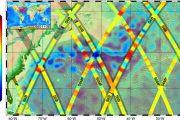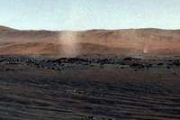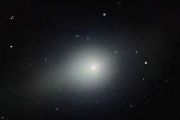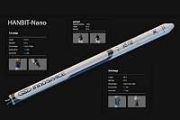
Copernical Team
T-Satellite powers smartphone apps beyond cell coverage
 T-Mobile (NASDAQ: TMUS) has expanded its T-Satellite partnership with Starlink to deliver satellite-powered app connectivity to more smartphones across the U.S., enabling popular services like WhatsApp, X, AccuWeather, AllTrails, and more to operate even without a cellular signal. The announcement marks a major leap just two months after T-Satellite's commercial debut with messaging and text-to-
T-Mobile (NASDAQ: TMUS) has expanded its T-Satellite partnership with Starlink to deliver satellite-powered app connectivity to more smartphones across the U.S., enabling popular services like WhatsApp, X, AccuWeather, AllTrails, and more to operate even without a cellular signal. The announcement marks a major leap just two months after T-Satellite's commercial debut with messaging and text-to- Giant double-ring radio galaxy found halfway across the universe
 Astronomers have discovered the most distant and powerful odd radio circle (ORC) ever observed, revealing a rare cosmic structure nearly halfway across the universe. The newly identified source, RAD J131346.9+500320, lies at a redshift of about 0.94 - when the universe was roughly half its present age.
These enormous, faint rings of magnetised plasma emit only in the radio band and typical
Astronomers have discovered the most distant and powerful odd radio circle (ORC) ever observed, revealing a rare cosmic structure nearly halfway across the universe. The newly identified source, RAD J131346.9+500320, lies at a redshift of about 0.94 - when the universe was roughly half its present age.
These enormous, faint rings of magnetised plasma emit only in the radio band and typical Cosmic constants may explain away dark matter and dark energy
 For decades, astronomers have assumed that dark matter and dark energy dominate the cosmos. Now, new research from the University of Ottawa challenges that foundation, proposing that these unseen components may be illusions caused by the gradual weakening of nature's fundamental forces as the universe ages.
Rajendra Gupta, Adjunct Professor in the Department of Physics, suggests that if th
For decades, astronomers have assumed that dark matter and dark energy dominate the cosmos. Now, new research from the University of Ottawa challenges that foundation, proposing that these unseen components may be illusions caused by the gradual weakening of nature's fundamental forces as the universe ages.
Rajendra Gupta, Adjunct Professor in the Department of Physics, suggests that if th Detection of phosphine in a brown dwarf atmosphere raises more questions
 Phosphorus is one of six key elements necessary for life on Earth. When combined with hydrogen, phosphorus forms the molecule phosphine (PH3), an explosive, highly toxic gas. Found in the atmospheres of the gas giant planets Jupiter and Saturn, phosphine has long been recognized as a possible biosignature for anaerobic life, as there are few natural sources of this gas in the atmospheres of terr
Phosphorus is one of six key elements necessary for life on Earth. When combined with hydrogen, phosphorus forms the molecule phosphine (PH3), an explosive, highly toxic gas. Found in the atmospheres of the gas giant planets Jupiter and Saturn, phosphine has long been recognized as a possible biosignature for anaerobic life, as there are few natural sources of this gas in the atmospheres of terr Young rogue planet displays record-breaking 'growth spurt'
 A young rogue planet about 620 light-years away from Earth has experienced a record-breaking "growth spurt," hoovering up some six billion tons of gas and dust each second over a couple of months.
A team of international researchers have explored changes in the planet's growth and immediate surroundings. The observations provide insight into how rogue planets - free-floating planetary-mass
A young rogue planet about 620 light-years away from Earth has experienced a record-breaking "growth spurt," hoovering up some six billion tons of gas and dust each second over a couple of months.
A team of international researchers have explored changes in the planet's growth and immediate surroundings. The observations provide insight into how rogue planets - free-floating planetary-mass Most powerful cosmic radio ring yet found by citizen scientists
 The most distant and powerful odd radio circle (ORC) ever detected has been discovered by astronomers working with citizen scientists.
ORCs are giant, faint rings of radio emission surrounding galaxies, visible only in radio wavelengths and composed of relativistic, magnetised plasma. First identified in 2019, only a few confirmed examples exist, most spanning 10-20 times the diameter of t
The most distant and powerful odd radio circle (ORC) ever detected has been discovered by astronomers working with citizen scientists.
ORCs are giant, faint rings of radio emission surrounding galaxies, visible only in radio wavelengths and composed of relativistic, magnetised plasma. First identified in 2019, only a few confirmed examples exist, most spanning 10-20 times the diameter of t Rogue planet devours matter at record pace of six billion tonnes a second
 Astronomers using the European Southern Observatory's Very Large Telescope (ESO's VLT) have witnessed an extraordinary growth spurt in a free-floating planet, observing it accumulate mass at a rate of six billion tonnes per second - the fastest accretion ever recorded for a rogue planet or any planet to date.
Rogue planets drift through space untethered to any star. The newly studied objec
Astronomers using the European Southern Observatory's Very Large Telescope (ESO's VLT) have witnessed an extraordinary growth spurt in a free-floating planet, observing it accumulate mass at a rate of six billion tonnes per second - the fastest accretion ever recorded for a rogue planet or any planet to date.
Rogue planets drift through space untethered to any star. The newly studied objec New tabletop detector to capture gravitational waves in the milli-Hz range
 Scientists have proposed a groundbreaking method to detect gravitational waves in the milli-Hertz frequency range, unlocking a new observational window into the universe. This advance could allow researchers to study astrophysical and cosmological events invisible to existing detectors.
Gravitational waves - minute ripples in spacetime first predicted by Einstein - have so far been observe
Scientists have proposed a groundbreaking method to detect gravitational waves in the milli-Hertz frequency range, unlocking a new observational window into the universe. This advance could allow researchers to study astrophysical and cosmological events invisible to existing detectors.
Gravitational waves - minute ripples in spacetime first predicted by Einstein - have so far been observe Vantor and Lanteris mark new era for space intelligence and defense technology
 Vantor and Lanteris Space Systems - formerly Maxar Intelligence and Maxar Space Systems, respectively - have each launched bold new identities, marking the completion of a historic transformation for the companies once united under Maxar Technologies. The dual rebrands reflect the group's strategic evolution into two complementary entities driving innovation across spatial intelligence, defense
Vantor and Lanteris Space Systems - formerly Maxar Intelligence and Maxar Space Systems, respectively - have each launched bold new identities, marking the completion of a historic transformation for the companies once united under Maxar Technologies. The dual rebrands reflect the group's strategic evolution into two complementary entities driving innovation across spatial intelligence, defense Curtin powers global push to find life on Mars and advance autonomy
 Curtin University is helping unlock the secrets of life on Mars and advance next-generation robotics and autonomous systems, with two new international agreements signed this week at the International Astronautical Congress in Sydney.
Curtin signed a Statement of Strategic Intent to formalise the LifeSpringsMars Working Group, and a Memorandum of Understanding (MoU) with India-based techno
Curtin University is helping unlock the secrets of life on Mars and advance next-generation robotics and autonomous systems, with two new international agreements signed this week at the International Astronautical Congress in Sydney.
Curtin signed a Statement of Strategic Intent to formalise the LifeSpringsMars Working Group, and a Memorandum of Understanding (MoU) with India-based techno 



























